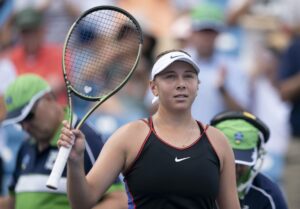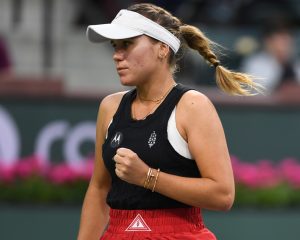Home Slam – two words that can seemingly strike fear (or at the very least extreme nervousness) into the hearts of even the very greatest tennis players, as Australia’s Ash Barty has unfortunately become the latest to discover. The World No.1’s disappointing defeat to No.14 seed Sofia Kenin in the Australian Open semi-final is yet another example of how difficult it can be to win a Major on home soil, or even home hard-court.
Of course, the majority of tennis players do not have a home Slam. It is only players from the four historic homes of tennis – in Australia, France, England and the USA – who get to experience the unique opportunity, and unique pressure, of trying to win a Major tournament in their own country. Only those players get to enjoy home support. Equally, only those players get to endure the often suffocating pressure of knowing that almost every one of their fellow countrymen and women is watching them and willing them on.
Perhaps that is why so many players win their first Major away from home, including Barty herself of course, who won the French Open last year. However, for the select few who can triumph in their own Major, there is probably nothing like it, even if they have already won a Major elsewhere beforehand.
Here, then, are the Five Finest Home Slam Victories in Tennis History.
- PETE SAMPRAS WINNING THE 2002 US OPEN
Putting Pistol Pete in this list might seem perverse to some, especially as I have not chosen his first US Open triumph in 1990 (which was also his first Major win anywhere) and because he went on to win his home Slam three more times in that decade (1993, 1995 and 1996). However, it is his fifth US Open win, a dozen years after his first, that is so remarkable that it demands inclusion in this list of all-time great home Slam victories.
Nearly 20 years on, it is easy to forget how extraordinary Sampras’s 2002 US Open win was. If not quite in the class of Roger Federer’s 2017 Australian Open victory, which was the great Swiss’s first Major victory in nearly five years, for comeback glory, it was still Sampras’s first Major triumph in more than two years (since Wimbledon 2000) and came after he had lost the previous two US Open Finals in straight sets to Marat Safin and Lleyton Hewitt respectively. Put simply, before the tournament started many experts thought that Sampras would never win another Major.
However, as he did so often throughout his career, Sampras proved them all wrong. He beat Andre Agassi, his fellow American and greatest rival, in four sets in the Final (6–3, 6–4, 5–7, 6–4) and although he did not retire immediately afterwards, his 2002 home Slam victory ultimately proved to be his swansong – not just his last Major win, but the last Major he competed in and indeed the last tournament of any kind that he ever played in. It was not apparent at the time, but in retrospect it was the perfect way to bow out for one of the game’s greatest ever players.
- YANNICK NOAH WINNING THE 1983 FRENCH OPEN
After Wimbledon – and by extension, Britain as a whole – had waited so long for a home Men’s Singles Champion (there was a wait of 77 years between Fred Perry’s final Wimbledon win in 1936 and Andy Murray’s 2013 victory), it is somewhat ironic that Wimbledon is now the Major that has most recently seen a home male victor. In the US, the wait is now 18 years, after the aforementioned Sampras victory in 2002; in Australia, the wait is now 44 years, since Mark Edmondson’s 1976 victory (more of which is coming up); and in France, the wait is now 37 years, since Yannick Noah became the King of Clay on his home red dirt in 1983.
Those statistics are another testament to how difficult it is for a tennis player to win their home Slam. And before Noah won in 1983, France had already endured what seemed like the most agonising of waits, since Marcel Bernard had beaten Jaroslav Drobný, the great Czech, in an epic five-setter in 1946, which was the first staging of the tournament after World War Two.
Just like Bernard 37 years earlier, Yannick Noah was not the favourite in the 1983 Final, as he was facing the defending champion, Mats Wilander. However, unlike so many other players in tennis history (a list that now includes, unfortunately for her, Ash Barty), Noah absolutely revelled in the home support that he enjoyed, rather than regarding it as a source of extra pressure. He played the greatest match of his career to beat the great Swede in straight sets, 6–2, 7–5, 7–6 (7–3). Even more remarkably, in doing so he became the last player of either gender to win a Grand Slam tournament with a wooden racket.
- MARK EDMONDSON WINNING THE 1976 AUSTRALIAN OPEN
Mark Edmondson’s victory in his home Major in 1976 was so extraordinary that, frankly, it is remarkable that there has not yet been a Hollywood (or at least Australian) movie about it. He is not only the last Australian man to win the Australian Open but even more impressively he remains to this day the lowest-ranked man (at 212) to win a Major since the official world rankings began in 1973, a record that will probably never be beaten.
However, neither numbers nor statistics can fully convey the truly seismic shock of Edmondson’s triumph. His ranking was so low before the tournament began that he was only admitted to it at the last moment, after a number of higher-ranked players had pulled out. Even more extraordinarily, at a time when tennis was only just beginning to become fully professional (the Open Era had only begun less than a decade earlier in 1968), prior to competing in and eventually winning the 1976 Australian Open, Edmondson had had to take a number of non-tennis jobs to help support himself, including – famously – briefly working as a cleaner.
In the end, of course, Edmondson cleaned up at his home Slam. Perhaps it was because he was ranked so low and was generally so little regarded that he did not experience the kind of acute pressure and intense scrutiny that Ash Barty has clearly struggled with in Melbourne over the last fortnight. In what The New York Times later described as “The Last Gasp of Australian Tennis’s Golden Age”, he beat several more highly ranked compatriots, culminating in a four-set victory (6–7, 6–3, 7–6, 6–1) in the final against John Newcombe, the defending champion.
- ANDY MURRAY WINNING WIMBLEDON IN 2013
Judged purely in tennis terms, Andy Murray’s genuinely historic Wimbledon victory in 2013, which came very nearly a full century after Fred Perry’s 1936 victory, should be at the top of this list. That is because it is surely unarguable that no other tennis player has ever come under the kind of pressure on court that Murray experienced when he confronted Novak Djokovic and ultimately overcame the great Serb in straight sets in the Final, 6–4, 7–5, 6–4.
In Britain, the search for a male Wimbledon Champion had become a kind of Holy Grail, as successive generations of British men came and went without ever really looking like they could end the increasingly long wait for a worthy successor to the great Fred Perry. The closest that any of them ever came was when Tim Henman reached four semi-finals in the late 1990s and early noughties, succumbing to Pete Sampras twice, Lleyton Hewitt once and – most agonisingly of all – losing to Goran Ivanisevic in 2001, when rain stopped the match when Henman was on top, a development that finally made the case for a roof on Centre Court unanswerable.
A dozen years later, Andy Murray reached his second Wimbledon Final, having lost the 2012 Final to Roger Federer, ironically, on that occasion, when rain necessitated the closure of the Centre Court roof after Murray had won the first set. But in the 12 months after that most devastating of defeats, Murray had not only won his first Major (at the 2012 US Open) but had already “won” at Wimbledon, after taking the 2012 Olympic Men’s Singles title when the Games were held in London. Consequently, when he faced Djokovic in the 2013 Final, nothing could stop him from ending the longest wait in British sporting history.
- ALTHEA GIBSON WINNING THE 1957 AND 1958 US CHAMPIONSHIPS
Although Andy Murray’s 2013 Wimbledon win is the greatest ever home Slam victory purely in sporting terms, Althea Gibson’s back-to-back triumphs at her home Slam – the US Championships (as it was called until it was renamed the US Open in 1968) – still tops it, precisely because Gibson’s victories transcended sport. As the first black player of either gender to win Majors (beginning with her victory at the 1956 French Open), Gibson overcame obstacles that white players could only imagine, and indeed obstacles that even the great black players who followed her – from Arthur Ashe to the Williams sisters – did not have to face. She literally changed the course of tennis history.
That was because Gibson began playing tennis at a time when the sport, like virtually every other aspect of US life, was effectively closed off to people of colour such as herself. As a result, unlike virtually every other champion before or since, Gibson did not begin playing tennis on a court but on the streets of her native New York, before a group of black businessmen began sponsoring her to play in the “Negro-only” tournaments of the time. Gibson, however, was such an incredible talent that she soon graduated from those tournaments to the full tour, where for most of her career she was the only black player of note.
Perhaps more than any other player in history, Gibson’s Major triumphs illustrate the double-edged sword that competing at a home Slam can represent for a tennis player. Like so many other great players before or since, she actually won her first Major on foreign soil, or rather clay, at Roland Garros in 1956. But then she backed that up with two of the most extraordinary seasons in tennis history, winning back-to-back Wimbledon and US titles in 1957 and 1958. And the titles that she won in New York, in the very city where she had originally been unable to compete in almost all the tournaments that existed purely because she was supposedly the wrong colour, must have been her sweetest victories of all. In overcoming such incredible odds to win at home – a home that, as for many African-Americans at the time, was hardly the most welcoming – make hers the greatest home Slam victories in tennis history.
Tennis History Main Photo:






